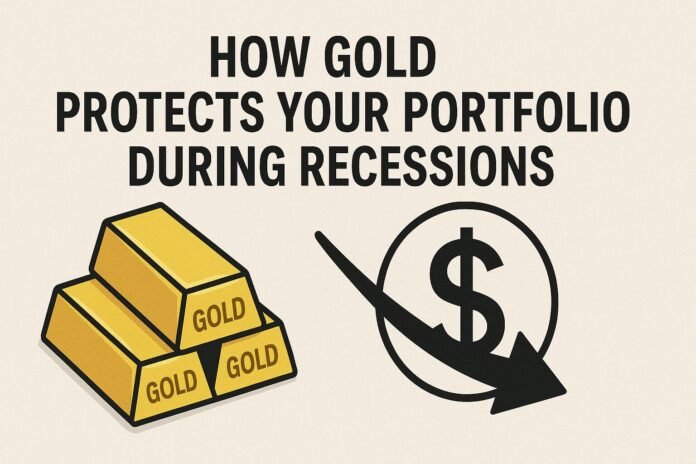When the economy starts to falter, smart investors often reach for gold. Acting as a proven gold recession hedge throughout market cycles, this precious metal offers a financial sanctuary during uncertain times. But why exactly do gold and silver become so valuable when times get tough?
Throughout history, gold has been the go-to safe haven when other investments start to crumble. While stocks dive and real estate cools during recessions, gold often follows its own path — one that can help keep your overall wealth intact.
What Makes Gold Special During Tough Economic Times?
When recession hits, traditional investments typically take a beating. Stock markets can crash, property values often sink, and even bonds can become shaky if interest rates swing wildly. During these rough patches, gold often follows a completely different pattern — one that can help shield your hard-earned wealth.
Why Gold Behaves Differently During Recessions
Gold has four unique characteristics that make it especially valuable as a gold recession hedge during economic downturns:
- Store of Value: It preserves purchasing power. While the dollar in your wallet gradually buys less over time, gold has maintained its value for centuries. What could buy a fine suit of clothes in Roman times could still buy quality clothing today.
- No Counterparty Risk: Gold ownership doesn’t depend on anyone’s promises. Unlike stocks or bonds, physical gold doesn’t require any company or government to fulfill their obligations — something that becomes critically important when financial systems are under stress.
- Global Recognition: It’s universally valued. Gold’s worth is recognized worldwide, regardless of political boundaries or which economies are currently struggling.
- Limited Supply: New supply is naturally limited. Unlike currency that can be created with the press of a button, gold supply only grows by about 1.5% each year, helping protect it from value dilution.
Historical Performance: Gold as a Proven Recession Hedge
Gold’s performance during past recessions tells a compelling story about its strength as a gold recession hedge. Let’s examine the evidence:
The 2008 Financial Crisis: Gold Shines While Markets Crumble
When the housing bubble burst and triggered the Great Recession (December 2007 to June 2009), most investors watched in horror as their portfolios collapsed. But gold owners had a different experience:
- While the S&P 500 plunged -38.5% in 2008 alone, gold gained 5.8%
- In 2009, as many were still recovering losses, gold rose another 23.9%
The Dot-Com Crash (2001): A Tech Bubble Bursts, Gold Bubbles Up
As internet companies imploded and investors learned the hard lesson that profits matter:
- Gold quietly climbed from around $270 per ounce to over $340
- This 25%+ gain came during a period when the tech-heavy NASDAQ lost nearly 80% of its value
- Many investors who diversified with gold avoided the full impact of the tech collapse as gold began a bull market that would continue for the next decade
The Early 1980s Recession: Gold During Stagflation
The double-dip recession of 1980-1982 brought a unique combination of high inflation and economic contraction:
- While Federal Reserve Chairman Paul Volcker pushed interest rates to nearly 20% to combat inflation, gold served as a refuge
- Gold hit then-unprecedented highs above $800 per ounce (equivalent to over $2,800 in today’s dollars)
- Even after the price correction that followed, gold maintained much of its value compared to pre-recession levels
This period demonstrated gold’s particular strength during inflationary recessions.
The COVID-19 Pandemic Recession (2020): Gold’s Modern Test
The shortest but one of the most severe economic contractions provides our most recent example:
- During the initial March 2020 panic, gold briefly fell alongside other assets as investors scrambled for cash
- Unlike many investments, gold quickly rebounded, reaching all-time highs above $2,000 per ounce by August 2020
- Gold finished 2020 with a 25.1% annual gain while many sectors struggled to recover
Even with unprecedented government stimulus flooding markets, investors still turned to gold as a hedge.
While each recession has unique characteristics, a pattern becomes clear: during times of serious economic stress, gold typically preserves wealth and often grows in value while traditional investments falter. This counter-cyclical behavior makes it a valuable component of a recession-resistant portfolio.
Gold vs. Other Assets During Recessions
Understanding how gold performs relative to other investments during economic downturns helps illustrate its value as a portfolio diversifier:
- Gold vs. Stocks: During the 2008 crisis, gold and stocks showed a strong negative correlation—when stocks plummeted, gold generally rose protecting investor portfolios. While major stock indices often take years to recover from recession lows, gold typically appreciates during economic contractions.
- Gold vs. Bonds: While government bonds offer safety, they remain vulnerable to interest rate changes and credit concerns. During inflationary recessions — like the early 1980s — gold substantially outperforms fixed-income investments
- Gold vs. Cash: Cash might feel safe during market turbulence, but inflation — often following recession-era stimulus — steadily erodes its value. Historical data shows gold maintains purchasing power better than cash through economic cycles
The Gold-to-Silver Ratio During Recessions
The gold-to-silver ratio — the price of gold divided by the price of silver — provides valuable insights for precious metals investors during economic downturns. During recessions, this ratio typically expands as investors favor gold’s safety over silver. As recovery begins, the ratio contracts when silver’s industrial demand recovers.
While historical averages hover around 60:1, market volatility can cause dramatic swings. Between 2014-2023, the ratio fluctuated between 70:1 and 85:1, with significant movements during economic shifts. During extreme stress in March 2020, it briefly exceeded 120:1.
We’ve discussed how the current gold-to-silver ratio of approximately 100:1 stands well above historical norms, suggesting silver may be significantly undervalued. When the ratio reaches such elevated levels, it has often signaled an excellent opportunity to buy silver before an inevitable correction.
Portfolio Allocation Strategies for Recession Protection
Adding gold to your investment mix isn’t just about preparing for economic storms — it’s about building a more resilient portfolio in all conditions. Research shows that including 10-15% gold in a traditional 60/40 stock/bond portfolio has historically lowered volatility while maintaining similar returns over complete economic cycles. The real advantage appears during downturns, when gold’s protective qualities shine brightest.
Your ideal precious metals allocation depends on your personal comfort with market swings:
- Conservative investors who value stability should consider a higher allocation (8-10%) primarily in physical gold like American Eagles or Sovereign coins. Gold’s steady performance during market stress provides the protection and peace of mind you’re seeking.
- Moderate investors might aim for a balanced approach (5-8%) with a mix of gold and silver (perhaps 70/30). This combination offers both defensive protection and growth potential as economic conditions evolve.
- Growth-oriented investors with higher risk tolerance may want to allocate more toward silver than gold. Silver’s smaller market size means it can potentially deliver greater returns when market sentiment improves, though its industrial demand component also means more price volatility. A 3-5% allocation provides foundational protection while allowing you to pursue growth elsewhere.
Remember that precious metals aren’t just for recessions—they’re valuable portfolio components throughout economic cycles, providing both diversification and protection against currency devaluation over the long term.
Understanding the Limitations of Gold as a Recession Hedge
While gold offers significant portfolio protection, responsible investors should acknowledge its limitations:
- Gold doesn’t generate income or dividends like stocks or bonds, meaning it relies entirely on price appreciation for returns.
- Physical gold ownership comes with practical considerations like storage and insurance expenses.
- Though generally less volatile than stocks, gold can still have major price swings that might test your resolve as an investor. Its prices don’t always move predictably in the short term, sometimes creating temporary losses even during periods when it “should” perform well.
During severe liquidity crises (as seen briefly in March 2020), gold can temporarily move in the same direction as other assets when investors are forced to sell quality holdings to cover losses elsewhere. These correlation breakdowns typically resolve quickly but can undermine gold’s protective role precisely when you’re counting on it most.
How to Add Gold to Your Portfolio
If you’re convinced that gold deserves a place in your investment strategy as a recession hedge, here are several options to consider:
Physical Gold: Coins and bars offer direct ownership without counterparty risk. Popular options include American Eagles, Canadian Maple Leafs, and standard gold bars from reputable refiners.
Gold ETFs: Funds like GLD provide exposure to gold prices without the need to store physical metal, though they come with management fees and counterparty considerations.
Gold Mining Stocks: Companies that produce gold offer leverage to gold prices but introduce business risks alongside gold exposure.
Gold IRAs: For retirement-focused investors, specialized gold IRAs allow for tax-advantaged precious metals ownership within retirement accounts.
Conclusion: Gold’s Role as a Recession Hedge in Resilient Portfolios
Throughout history, gold has proven itself a reliable protector of wealth during economic downturns. While no investment is perfect, gold’s unique properties make it particularly valuable when traditional assets struggle.
By understanding gold’s historical performance during recessions and thoughtfully incorporating it into your portfolio, you can build greater resilience against economic uncertainty while maintaining long-term growth potential.
Stay Informed: Get Our Market Alerts
JP Morgan has raised their recession forecast to 60%. Don’t miss our critical updates as this rare market event unfolds.
Disclaimer: This article is for informational purposes only and should not be considered financial advice. Always consult with a qualified financial advisor before making investment decisions. Historical performance is not indicative of future results.



